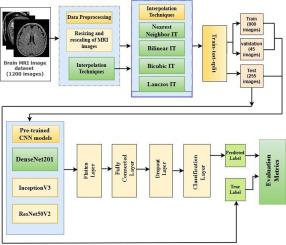将插值技术与深度学习相结合,实现脑肿瘤的准确分类
Journal of Computational Mathematics and Data Science
Pub Date : 2025-07-26
DOI:10.1016/j.jcmds.2025.100124
引用次数: 0
摘要
人工智能(AI)驱动的计算机视觉技术彻底改变了医学图像分析(MIA),实现了对脑肿瘤等各种疾病的准确检测、诊断和治疗。脑肿瘤是世界范围内影响成千上万人的主要健康问题。准确识别和诊断脑肿瘤对于有效的治疗和预期寿命至关重要。目前人工智能的进步,特别是深度学习(DL)方法,已经显示出分析医学图像(包括MRI)的巨大可能性。然而,MRI图像的质量显著影响分类框架的整体准确性。为了解决这个问题,我们研究了各种插值技术(IT)对增强磁共振成像(MRI)图像质量的影响,包括最近邻插值技术(IT)、双线性插值技术(IT)、双三次插值技术(IT)和Lanczos插值技术。此外,我们使用迁移学习来利用预训练的卷积神经网络(cnn)架构,特别是DenseNet201。我们提出了一种改进的DenseNet201模型,通过添加额外的层并从插值的脑MRI图像中提取特征。我们使用了两个公开的脑肿瘤数据集。我们的实验结果表明,Lanczos IT和微调后的DenseNet201组合在Dataset-1和Dataset-2中分别获得了99.21%和99.60%的最高脑肿瘤分类准确率。我们的分析强调了图像插值技术在提高医学图像质量和最终提高诊断准确性方面的重要性。我们的研究结果对医学成像中人工智能决策支持系统的发展具有重要意义,使医疗保健专业人员能够做出更准确的诊断和明智的治疗决策。本文章由计算机程序翻译,如有差异,请以英文原文为准。

Integrating interpolation techniques with deep learning for accurate brain tumor classification
Artificial Intelligence (AI)-powered Computer vision techniques have revolutionized Medical Image Analysis (MIA), enabling accurate detection, diagnosis, and treatment of various disorders such as brain tumors. Brain tumors are a worldwide primary health concern that affects thousands of people. Precisely identifying and diagnosing brain tumors is vital for effective management and life expectancy. Current advances in AI, particularly in Deep Learning (DL) methods have shown immense possibilities to analyze medical images, including MRI. However, the quality of the MRI images significantly impact the overall accuracy of the classification framework. To tackle this issue, we investigated the effect of various Interpolation Techniques (IT) on enhancing Magnetic Resonance Imaging (MRI) image quality, including Nearest Neighbour IT, Bilinear IT, Bicubic IT, and Lanczos IT. Furthermore, we employed Transfer Learning to leverage pre-trained Convolutional Neural Networks (CNNs) architectures, specifically DenseNet201. We proposed a modified DenseNet201 model by adding additional layers and extracting features from the interpolated brain MRI images. We used two publicly available brain tumor datasets. Our experimental results illustrated that the combination of Lanczos IT and fine-tuned DenseNet201 attained the highest accuracy of 99.21% and 99.60% in Dataset-1 and Dataset-2, respectively, for brain tumor classification. Our analysis highlights the importance of image interpolation techniques in improving medical image quality and ultimately improving diagnostic accuracy. Our findings have significant implications for the development of AI-powered decision support systems in medical imaging, enabling healthcare professionals to make more accurate diagnoses and informed treatment decisions.
求助全文
通过发布文献求助,成功后即可免费获取论文全文。
去求助

 求助内容:
求助内容: 应助结果提醒方式:
应助结果提醒方式:


